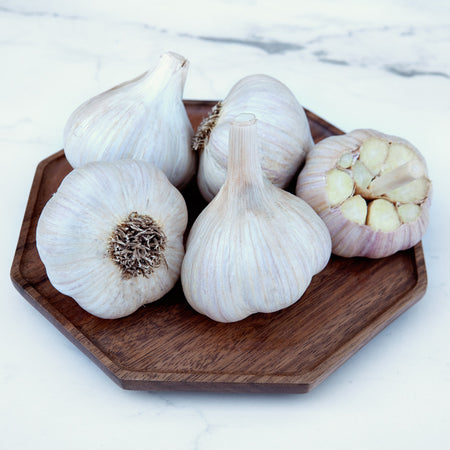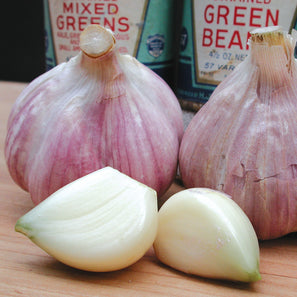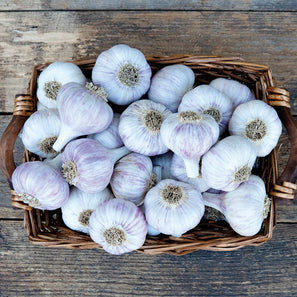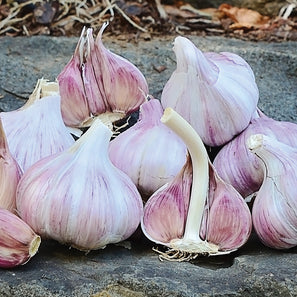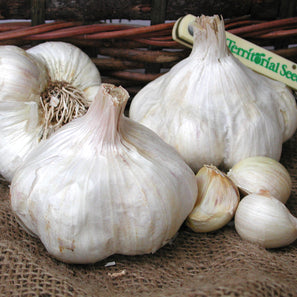ROSEWOOD
Product Description:
Garlic is shipped only in the fall—September through mid-October, depending on the season and the variety. Quantities are limited; order early for best availability. Sorry, not available to Idaho, US Territories, or Canada.
| Seed Depth | 2-3" |
| Seed Spacing | 6" |
| Cloves per Bulb | Hardneck: 5-10; Softneck: 6-18 |
| Cloves per Pound | Hardneck: 40-65; Softneck: 50-90 |
Folklore is rife with tales of garlic's ability to bestow strength and courage, treat a vast array of disease and infections, and to ward off evil. Modern day medicine has shown this remarkable food to be powerfully effective at boosting the immune system, supporting cardiovascular health, and fighting cancer.
Hardneck Garlic: Allium sativum subsp. ophioscorodon Cloves grow in a single circle around a central woody stem. These varieties also produce, or attempt to produce, a flower-like stalk. What makes these garlics stand out is the range and quality of flavors they exhibit. Hardneck garlics typically have a shorter storage life than softnecks.
Softneck Garlic: Allium sativum subsp. sativum These varieties produce cloves in several layers around a soft central stem. Approximate cloves per pound can vary based on seasonal conditions and the variety. These easy-to-grow garlics are excellent in the kitchen and usually have the best storage qualities. Great for braiding.
Elephant Garlic: Allium ampeloprasum Not a true garlic, these enormous bulbs have much milder and sweeter flavor than garlic, as it's related more closely to a leek. Elephant garlic is planted 6-8 inches apart and covered with 4-6 inches of soil.
Culture
• Garlic thrives in rich, well-drained soil with a pH between 6.0-7.0
• Work in 1 inch layer of compost, 1/2 cup of bone meal, 1/2 cup TSC's Complete fertilizer per 5 row feet
• When spring growth begins: water to keep the soil slightly moist and fertilize with Age Old Grow or TSC's Complete fertilizer
• As harvest approaches: water less to avoid molding or staining
• Hardnecks: cut off any flowering stems (scapes) at the top leaf to redirect energy to the bulb; scapes can be used like green onions
Direct Sowing
• In Northern regions, garlic is best planted by the end of October, or 6-8 weeks before the ground freezes
• Southern regions may plant as late as March
• Separate the cloves of garlic just prior to planting, keeping as much skin on as possible
• Plant cloves pointed end up
• Mulch with clean straw or leaves to 4 inches
Pests & Diseases
• Common pests: onion thrips, stem & bulb nematodes
• Pest control: Pyrethrin, 5–7 year crop rotation
• Common diseases: Gray mold/Botrytis, rust
• Disease prevention: 5–7 year crop rotation, avoid soggy soil
Harvest & Storage
• Harvest when the top 4-5 leaves are slightly green and lower leaves are dry
• Begin checking for mature bulbs in late June
• Each green leaf represents one layer of covering over the bulb in the ground
• Tie the plants in small bundles and dry in a cool, shaded, well-ventilated location for about 3-4 weeks
• After curing is done, cut foliage and roots from bulbs and store in mesh bags
• Softnecks: you can keep leaves on and braid the whole plant

